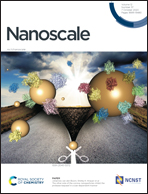A highly sensitive quartz crystal microbalance sensor modified with antifouling microgels for saliva glucose monitoring†
Abstract
Saliva glucose detection based on quartz crystal microbalance (QCM) technology has become an important research direction of non-invasive blood glucose monitoring. However, the performance of this label-free glucose sensor is heavily deteriorated by the large amount of protein contaminants in saliva. Here, we successfully achieved the direct detection of saliva glucose by endowing the microgels on the QCM chip with superior protein-resistive and glucose-sensitive properties. Specifically, the microgel networks provide plenty of boric acid binding sites to amplify the signals of targeted glucose. The amino acid layer wrapped around the microgel and crosslinking layer can effectively eliminate the impact of non-specific proteins in saliva. The designed QCM sensor has a good linearity in the glucose concentration range of 0–40 mg L−1 in the pH range of 6.8–7.5, satisfying the physiological conditions of saliva glucose. Moreover, the sensor has excellent ability to tolerate proteins, enabling it to detect glucose in 50% human saliva. This result provides a new approach for non-invasive blood glucose monitoring based on QCM.



 Please wait while we load your content...
Please wait while we load your content...